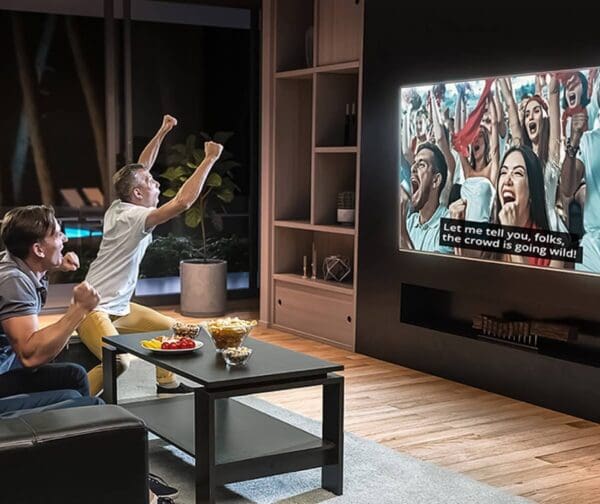
Watching TV and Movies with Hearing Loss
Watching TV and Movies with Hearing Loss
Everyone loves a good movie, and we’re living in the Second Golden Age of Television. But if you’re d/Deaf or hard of hearing, it can be a struggle to gain equal access to your favorite shows, the latest movies, or the most-talked-about online videos.
Below, we take a look at some of the ways that you can enjoy video content if you’re d/Deaf or hard of hearing.
Gaining Equal Access to Content
During the silent film era, movies were accessible to both deaf and hearing audiences through the use of intertitles—text that appeared between shots and described dialogue and plot points. But everything changed with the coming of sound in 1927 with The Jazz Singer. Since then, d/Deaf and hard of hearing audiences have either had to rely on captioning—or have been left out completely.
Going to the Movies
At the movies—if there’s even a captioned showing available that’s not in the middle of the day—it can feel like you’re spending more time wrestling your (unreliable) CaptiView device into the cupholder than actually enjoying the movie. Just ask Nyle DiMarco or Ace Ratcliff.
In addition to the CaptiView device, some cinemas offer special captioning glasses.
Tech companies and startups have gotten in on the action. ActiView, founded by a former Johns Hopkins University computer science student, Alex Koren, has been making waves by bringing access via an app, eschewing traditional methods to bring captions directly to viewers on their mobile devices, allowing them to read along with the movie. Watch performer Rosa Lee Timm share her thoughts on ActiView here.
Watching Television
When it comes to television captioning, the US has come a long way since the 1972 debut of The French Chef on PBS, the first TV program to be captioned. With the Television Decoder Circuitry Act and the Americans with Disabilities Act, both passed in 1990, captioning on television became the norm. In Australia, the Australian Caption Centre (ACC) began providing captions for television programs in 1982. Captioning came to the UK in the 1970s.
Streaming Video Content
Captioning on TV has been the norm for a while, but on the Internet, it can be a different story.
When Marlee Matlin was a little girl, long before she became the youngest person to win an Academy Award for Best Actress, The Wizard of Oz inspired her to pursue acting. She fought to help pass the Television Circuitry Decoding Act so that d/Deaf and hard of hearing people could enjoy captioned TV—including a broadcast of The Wizard of Oz. But, in 2009, when she went to watch the movie on Netflix—and share it with her children—she was horrified to learn that it was not captioned. The National Association of the Deaf (NAD) later sued Netflix and won. Since 2014, streaming providers like Netflix and Hulu have had to have all of their content captioned.
But captioning of other online videos—like short clips on YouTube or even on news websites—remains spotty and unreliable. Trying to watch online videos can feel a lot like sitting with someone who refuses to put the captions on. That’s because many online videos remain uncaptioned, or online content creators and distributors rely on automatic captions—or, as Rikki Poynter puts it, “craptions.” (Learn more about her #NoMoreCraptions campaign here).
Captions benefit loads of people—from signing Deaf people to oral deaf people to those learning English as a Second Language—and quality captions ensure quality content reaches as many people as possible.
Using Technology
If you use hearing technology, be it hearing aids or cochlear implants, you can often stream audio straight from your TV to your device. That way, you can watch TV at a volume that’s comfortable and personalized just for you.
If you use Cochlear, here are instructions on how to use their TV Streamer with your Nucleus 6 or Nucleus 7. Accessories like these aren’t cheap, but some should be included when you upgrade to a new processor.
If you’re a hearing aid user, companies like ReSound also offer a TV Streamer.
If you don’t use hearing aids and have residual hearing, an “As Seen On TV” product like TV Ears might work for you. Sound bar speakers and wireless headphones are also becoming popular solutions to improve dialogue clarity. As we as consumers become more and more reliant on digital products, and as we demand more and more quality products to meet our ever-evolving needs, we certainly won’t see the end of these types of devices any time soon.
Making a Change
Legislation like the Americans with Disabilities Act in the US, the Equality Act in the UK, and the Disability Discrimination Act in Australia guarantee protections for people with disabilities, but in reality, life can be inaccessible.
Apart from the technology mentioned above, true change will really occur when we shift the culture and build a society that values true accessibility for individuals of all abilities.